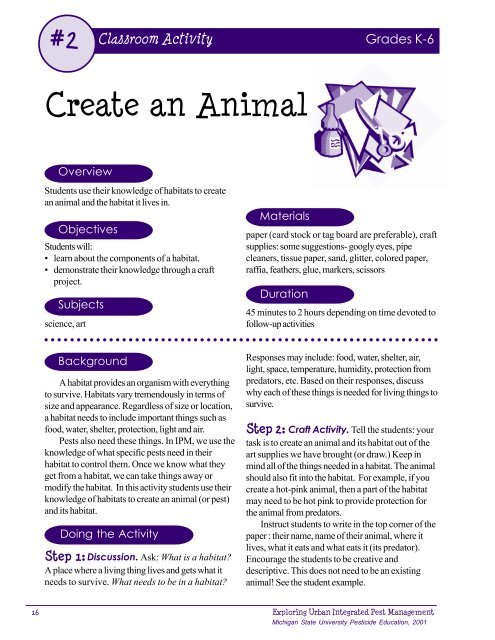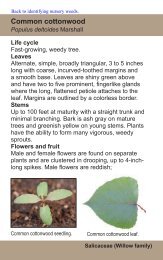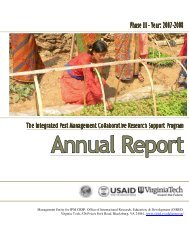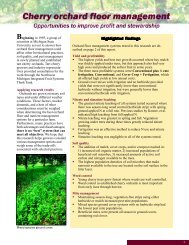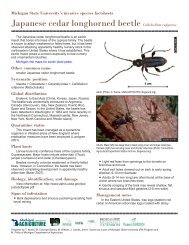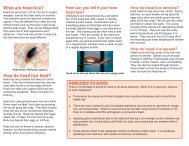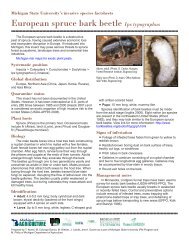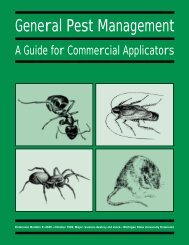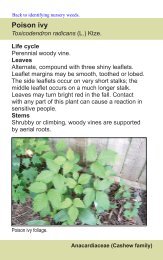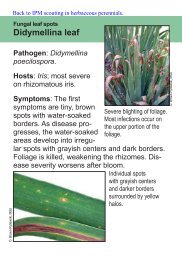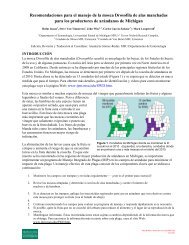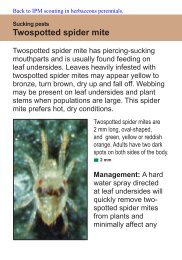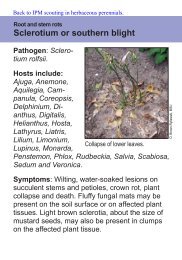Activities and Resources for Teaching K-6 - School Integrated Pest ...
Activities and Resources for Teaching K-6 - School Integrated Pest ...
Activities and Resources for Teaching K-6 - School Integrated Pest ...
Create successful ePaper yourself
Turn your PDF publications into a flip-book with our unique Google optimized e-Paper software.
#2<br />
Classroom Activity Grades K-6<br />
Create an Animal<br />
Overview<br />
Students use their knowledge of habitats to create<br />
an animal <strong>and</strong> the habitat it lives in.<br />
Objectives<br />
Students will:<br />
• learn about the components of a habitat.<br />
• demonstrate their knowledge through a craft<br />
project.<br />
Subjects<br />
science, art<br />
Materials<br />
paper (card stock or tag board are preferable), craft<br />
supplies: some suggestions- googly eyes, pipe<br />
cleaners, tissue paper, s<strong>and</strong>, glitter, colored paper,<br />
raffia, feathers, glue, markers, scissors<br />
Duration<br />
45 minutes to 2 hours depending on time devoted to<br />
follow-up activities<br />
○ ○ ○ ○ ○ ○ ○ ○ ○ ○ ○ ○ ○ ○ ○ ○ ○ ○ ○ ○ ○ ○ ○ ○ ○ ○ ○ ○ ○ ○ ○ ○ ○ ○ ○ ○ ○ ○ ○ ○ ○ ○ ○ ○ ○ ○ ○ ○ ○ ○ ○ ○ ○ ○ ○ ○ ○ ○ ○ ○ ○<br />
Background<br />
A habitat provides an organism with everything<br />
to survive. Habitats vary tremendously in terms of<br />
size <strong>and</strong> appearance. Regardless of size or location,<br />
a habitat needs to include important things such as<br />
food, water, shelter, protection, light <strong>and</strong> air.<br />
<strong>Pest</strong>s also need these things. In IPM, we use the<br />
knowledge of what specific pests need in their<br />
habitat to control them. Once we know what they<br />
get from a habitat, we can take things away or<br />
modify the habitat. In this activity students use their<br />
knowledge of habitats to create an animal (or pest)<br />
<strong>and</strong> its habitat.<br />
Doing the Activity<br />
Step 1: Discussion. Ask: What is a habitat?<br />
A place where a living thing lives <strong>and</strong> gets what it<br />
needs to survive. What needs to be in a habitat?<br />
Responses may include: food, water, shelter, air,<br />
light, space, temperature, humidity, protection from<br />
predators, etc. Based on their responses, discuss<br />
why each of these things is needed <strong>for</strong> living things to<br />
survive.<br />
Step 2: Craft Activity. Tell the students: your<br />
task is to create an animal <strong>and</strong> its habitat out of the<br />
art supplies we have brought (or draw.) Keep in<br />
mind all of the things needed in a habitat. The animal<br />
should also fit into the habitat. For example, if you<br />
create a hot-pink animal, then a part of the habitat<br />
may need to be hot pink to provide protection <strong>for</strong><br />
the animal from predators.<br />
Instruct students to write in the top corner of the<br />
paper : their name, name of their animal, where it<br />
lives, what it eats <strong>and</strong> what eats it (its predator).<br />
Encourage the students to be creative <strong>and</strong><br />
descriptive. This does not need to be an existing<br />
animal! See the student example.<br />
16 Exploring Urban <strong>Integrated</strong> <strong>Pest</strong> Management<br />
Michigan State University <strong>Pest</strong>icide Education, 2001


